How it stared
Okay, so I stumbled upon this video from Tech By Ralph about coding addiction, and honestly? It hit way too close to home. After spending months building scripts on my Raspberry Pi, automating backups on my Contabo server, and creating AI agents for my WordPress workflow, I finally understand what that “spark” everyone talks about really means. Let me share why coding became my obsession and how you can experience that same magic, even if you’re just starting out.

That First Magic Moment: When 1+1 Changed Everything
You know what’s funny? Ralph’s video starts with him typing “1+1” in Python and feeling like it was magic. And I’m sitting here thinking, “Damn, I remember that exact feeling.” But for me, it wasn’t adding numbers, it was watching my Raspberry Pi automatically connect to the strongest Wi-Fi signal at a coffee shop in District 1.
Picture this: I’m at my usual spot near Nguyen Hue, laptop open, bánh mì thịt nướng on the side (because priorities, right?), and I had just written this small Python script. Nothing fancy, maybe 50 lines of code that would scan available networks, check signal strength, attempt connection, and if it couldn’t ping Google servers, move to the next strongest signal in the sequence.
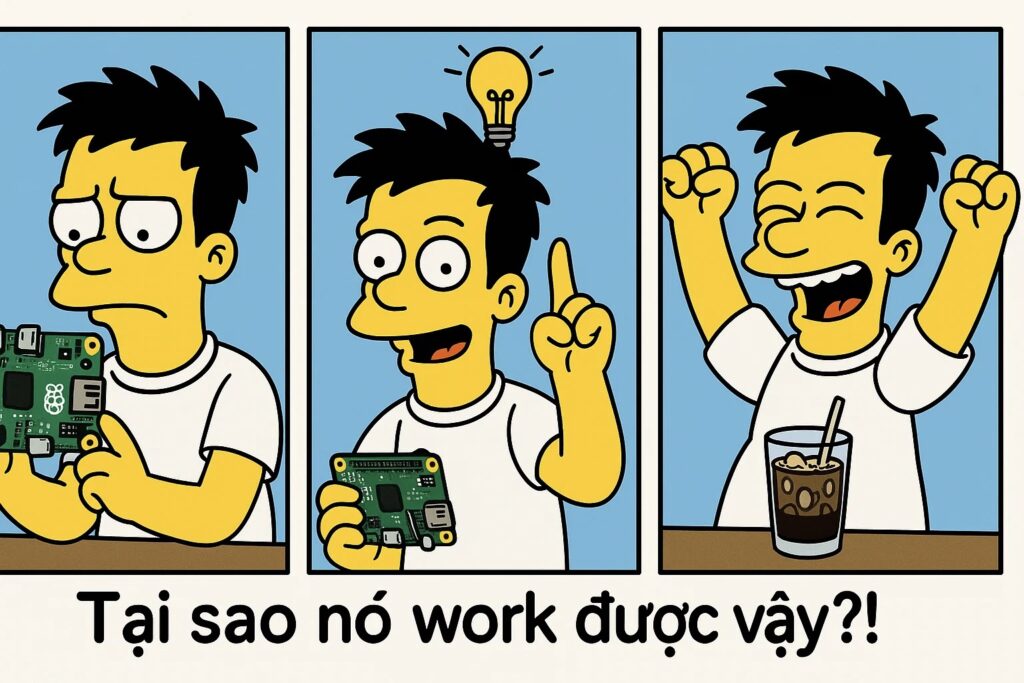
The moment that script ran successfully for the first time… ủa ? I literally stared at the terminal for like 5 minutes. This tiny computer was making decisions, testing connections, remembering which networks worked, and handling failures automatically. It was like watching a digital pet learn and adapt.
That’s when it hit me: I had just told a machine exactly what to do, and it listened. Not just listening, it was thinking through problems on my behalf.

The Automation Bug: From Wi-Fi Scripts to Docker Backups
PlantUML Diagram – Wi-Fi Auto-Connection Flow:

Once that Wi-Fi script worked, I couldn’t stop. You know what happened next? I started thinking about my Contabo server in Germany that hosts my Docker containers. Every night around 4 AM (Vietnam time), I was manually creating backups, zipping files, and copying them to different locations.
Tại sao mình phải thức dậy 4 giờ sáng để làm cái này? (Why do I need to wake up at 4 AM to do this?)
So I wrote another script. This one would automatically:
- Create timestamped backups of all Docker data
- Compress everything into neat zip files
- Copy backups to multiple locations (including my home machines)
- When my Raspberry Pi connects to the internet, it automatically pulls the latest backup
- Send me a Telegram notification with backup status

The crazy part? This “simple” backup script saved me probably 2-3 hours every week. But more importantly, it gave me this incredible feeling of control. My servers were taking care of themselves while I was sleeping, and I could focus on actual work instead of maintenance tasks.
When AI Enters the Picture: Context Engineering and Agent Workflows
Here’s where things get interesting. After those successful automation projects, I started exploring AI agents and context engineering. Remember that WordPress script I mentioned? Let me tell you that story…
I was getting tired of manually converting my Docmost notes into WordPress posts. The process was tedious: write in Docmost, export content, reformat for Gutenberg blocks, upload images, adjust layouts… ugh. So I thought, “What if I could automate this entire workflow?”
PlantUML Diagram – WordPress AI Workflow:

The result? A Python script that:
- Connects to Docmost API and retrieves my posts
- Converts markdown to proper Gutenberg blocks
- Hooks up with Google’s Gemini API to generate contextual images
- Automatically uploads everything to WordPress using application passwords
- Handles all the formatting, media uploads, and metadata
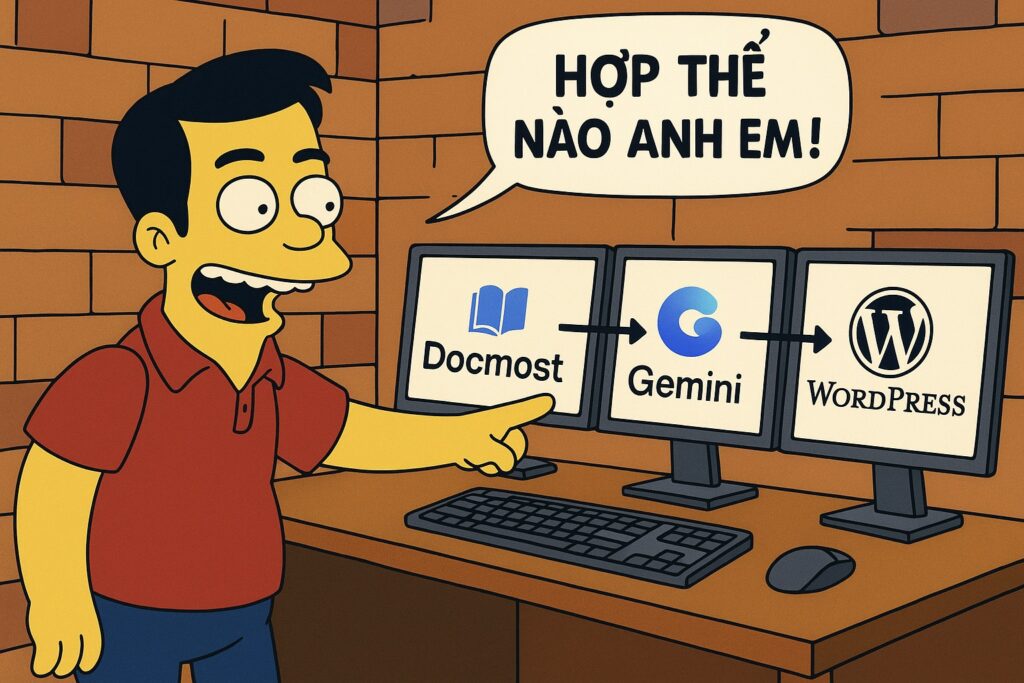
But here’s the thing Ralph mentions in his video about curiosity being the fuel, that’s exactly what happened. Once I got the basic WordPress integration working, I started wondering: “What else can I automate? What if I add automated tagging? What if I generate social media posts automatically? What if I create a complete content management AI?”
Each successful feature made me want to build ten more features.
The Database Analytics Project: When AI Met Academic Requirements
This curiosity-driven approach really paid off during my Business Intelligence and Data Analytics course. We had this final project where we needed to demonstrate ETL processes, data analysis, and present findings to the class.
Instead of doing another boring sales dashboard (which honestly, chắc lại là mấy cái test case, ai thèm ngồi viết đâu, probably just test cases again, who wants to write those), I pitched building an AI-powered HR screening platform.

The concept: candidates upload CVs, AI parses the content, extracts relevant data, compares against job descriptions, and provides screening recommendations. Sounds simple, right? Wrong.
Building this required:
- Fine-tuning system prompts to extract structured data from unstructured CVs
- Creating ETL pipelines to process different CV formats
- Building a web interface for candidates and HR teams
- Integrating multiple AI models for different analysis tasks
- Designing databases to store candidate profiles and job requirements
| Development Phase | Key Challenge | Solution Approach | What I Learned |
|---|---|---|---|
| Day 1 | CV parsing accuracy | Multiple prompt engineering iterations | AI responses need careful validation |
| Day 2 | Data structure design | Normalized database with flexible schema | Plan for data variety upfront |
| Day 3 | UI/UX for HR workflows | User research with actual HR professionals | Listen to real user needs |
| Day 4 | AI model integration | Modular API architecture | Build for flexibility and testing |
PlantUML Diagram – HR Screening AI Architecture:

The presentation day was incredible. When we demonstrated live CV parsing, real-time matching, and the AI’s reasoning for each candidate recommendation, the entire class went silent. Then someone asked, “Did you really build this in 4 days?”
And honestly? I told them exactly what I tell you now: “I didn’t just build this. I learned to think like the system while building it.”

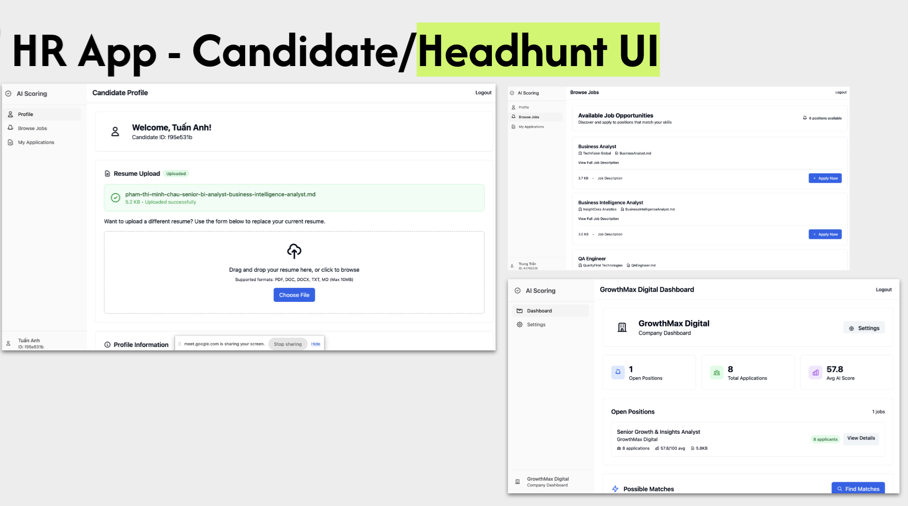
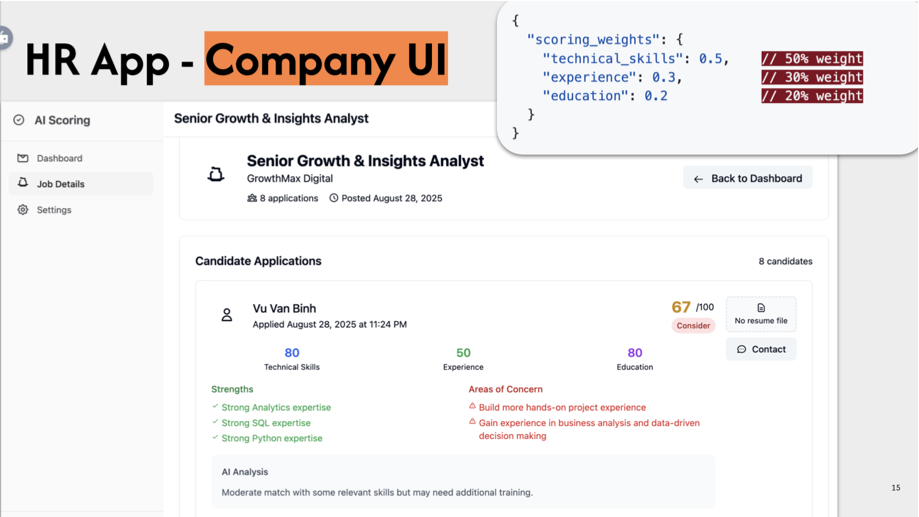
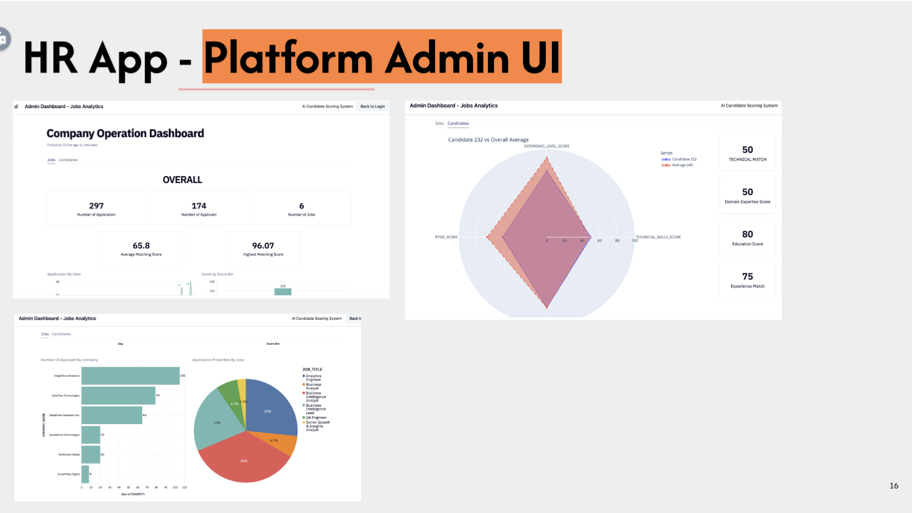
These are some UI on our app.
Why Coding Becomes Addictive: The Vietnamese Product guy’s Perspective
Ralph mentions in his video that coding becomes “dangerous” because it’s about freedom. As someone working in tech in Vietnam for the last 7-8 years, this hits differently for us.
In Vietnam, especially in HCMC, there’s this amazing entrepreneurial energy. Everyone’s building something, from street vendors optimizing their bánh mì delivery routes to startups creating fintech solutions for traditional markets. When you can code, you can participate in this innovation ecosystem in ways that weren’t possible before.

Here’s what I’ve learned about why coding becomes addictive, especially for Vietnamese professionals:
1. The Problem-Solving Cultural Fit
Vietnamese culture has this incredible “solve it yourself” mentality. When street vendors create their own inventory tracking systems using Zalo and Excel, that’s essentially programming logic, you know one of those Youtube tutorial about sending Zalo friend requests and automation task from Excel. When you learn actual coding, it’s like getting superpowers for this existing mindset.
2. Financial Independence Potential
Let’s be honest, the salary difference between traditional roles and tech roles in Vietnam is significant. But beyond that, coding skills open doors to remote work, freelancing, and creating your own products. That Raspberry Pi script I wrote? It’s now helping three other Vietnamese developers automate their home labs.
3. Learning Compound Effects
Every script I write teaches me something that improves the next script. The Wi-Fi automation helped me understand network programming. The backup system taught me about server management. The WordPress integration introduced me to API design. The HR screening platform combined everything with AI.
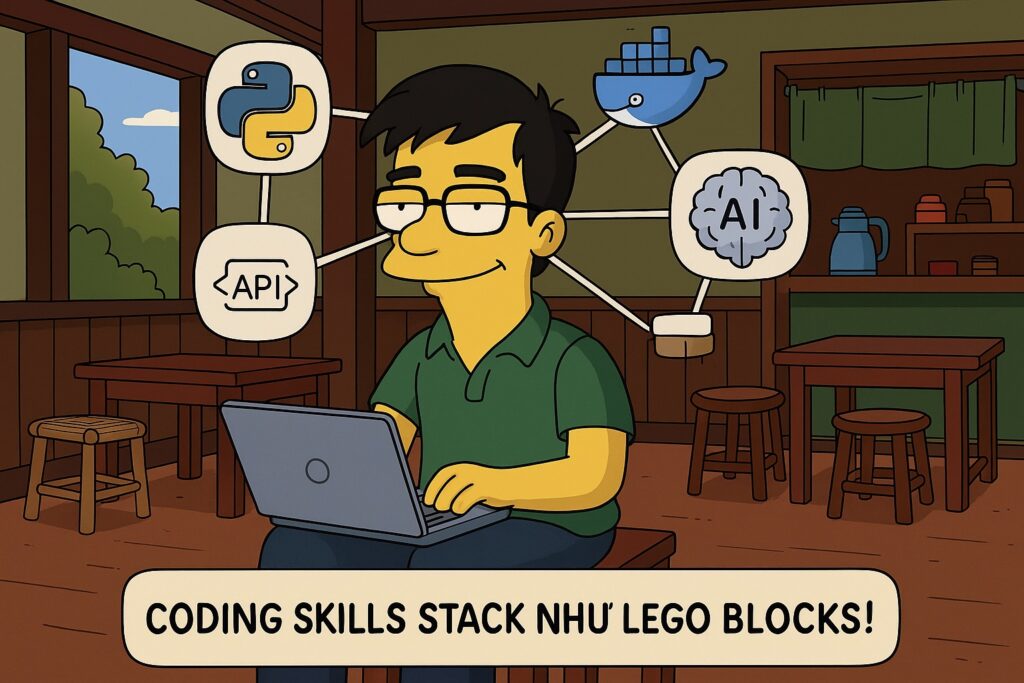
It’s like Ralph says in the video, you start with simple calculator, then wonder how it looks on mobile, then suddenly you’re building mobile apps.
For me, it was: simple automation script → server management → AI integration → complete platforms.
Cuong Nguyen
The Business Side: How Technical Skills Transform Your Career
As someone with a business background who’s worked in tech for years, I can tell you this: understanding the technical constraints and possibilities completely changes how you approach business problems.
Before I could code, I would propose solutions and hope the engineering team could build them. Now? I understand exactly what’s technically feasible, what’s expensive, what’s risky, and what’s innovative. This knowledge makes me a much better Product Manager/PO.
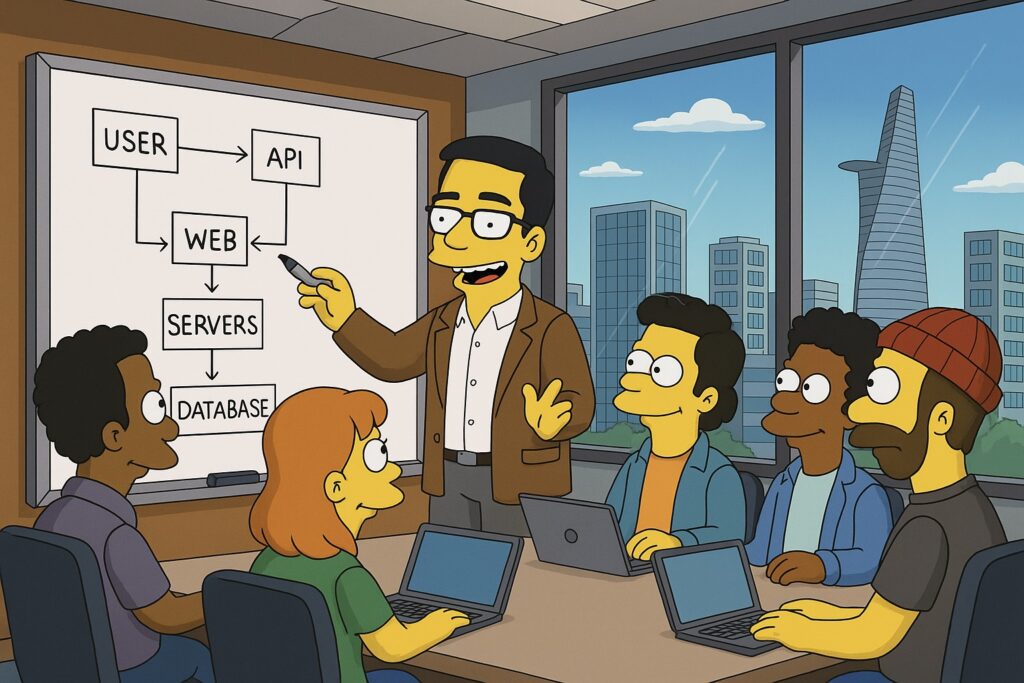
When stakeholders ask, “Can we add real-time notifications?” I don’t just say “let me check with engineering.” I can immediately discuss WebSocket implementations, server costs, mobile app implications, and alternative approaches. This technical literacy has been incredible for my career advancement.
Real Impact on Daily Work
| Before Learning to Code | After Learning to Code |
|---|---|
| “Is this technically possible?” | “Here are three ways to implement this, with trade-offs…” |
| “The API integration failed” | “The authentication token expired; here’s how to fix it” |
| “We need better automation” | “I built a prototype over the weekend; want to see?” |
| “Engineering says it’s complex” | “It’s complex because of X, Y, Z – here are alternatives” |
The Research Angle: Why Technical Skills Matter for Academic Work
Right now I’m preparing my Master thesis proposal for defense in 2027. Having hands-on experience with AI agents, API integrations, and system architectures has completely transformed how I approach research.
When I search academic databases on ScienceDirect, I actually understand the technical papers I’m reading. Terms like “neural network architectures,” “API rate limiting,” “distributed systems,” and “prompt engineering” aren’t mysterious concepts, they’re tools I’ve actually used.
PlantUML Diagram – Research Technical Integration:

This technical background gives me credibility when proposing research methodologies. Instead of theoretical frameworks, I can suggest practical implementations. Instead of abstract data collection methods, I can build actual data pipelines.
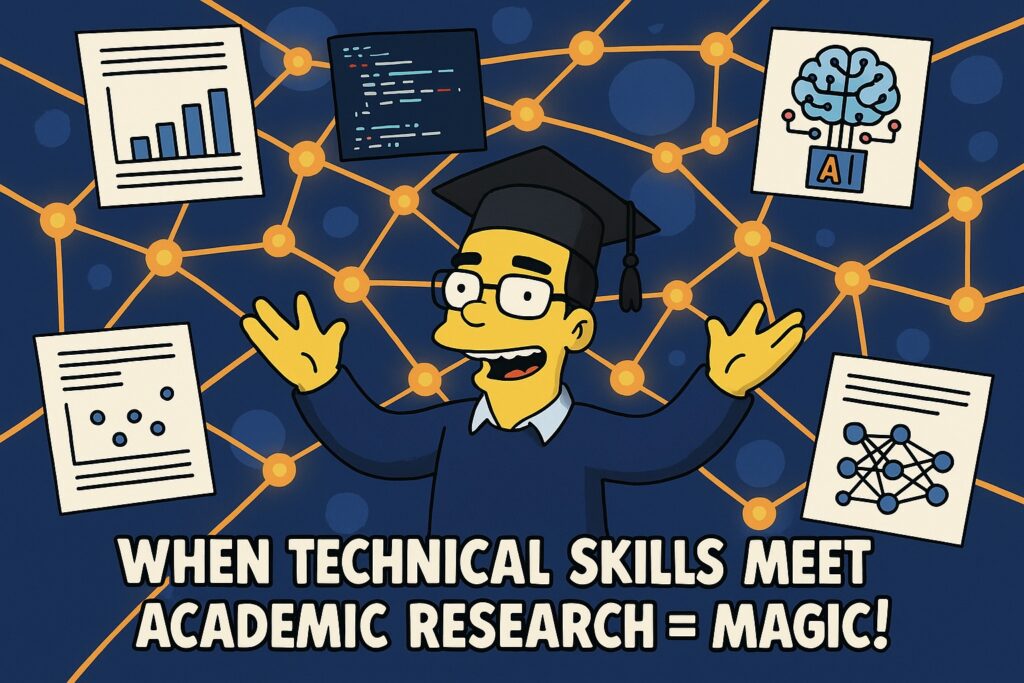
Addressing the “AI Will Replace Us” Concern
Okay, let’s address the elephant in the room. A lot of people are worried that AI will make coding obsolete. Ralph’s video talks about this briefly, but let me share my honest perspective after working with AI tools extensively.
After months of building AI agents and automating workflows, I still see AI as a powerful tool, not a replacement. Here’s why:
The Orchestra Conductor Analogy
Think of AI like having incredibly talented musicians. But someone still needs to be the conductor – deciding the tempo, coordinating different sections, ensuring the overall performance makes sense. That conductor role? That’s still very much human.
In my WordPress automation project, AI generates images and helps with content formatting. But I still need to:
- Define the overall workflow architecture
- Write the integration logic between different APIs
- Handle error cases and edge conditions
- Make strategic decisions about features and priorities
- Understand business requirements and translate them to technical specifications
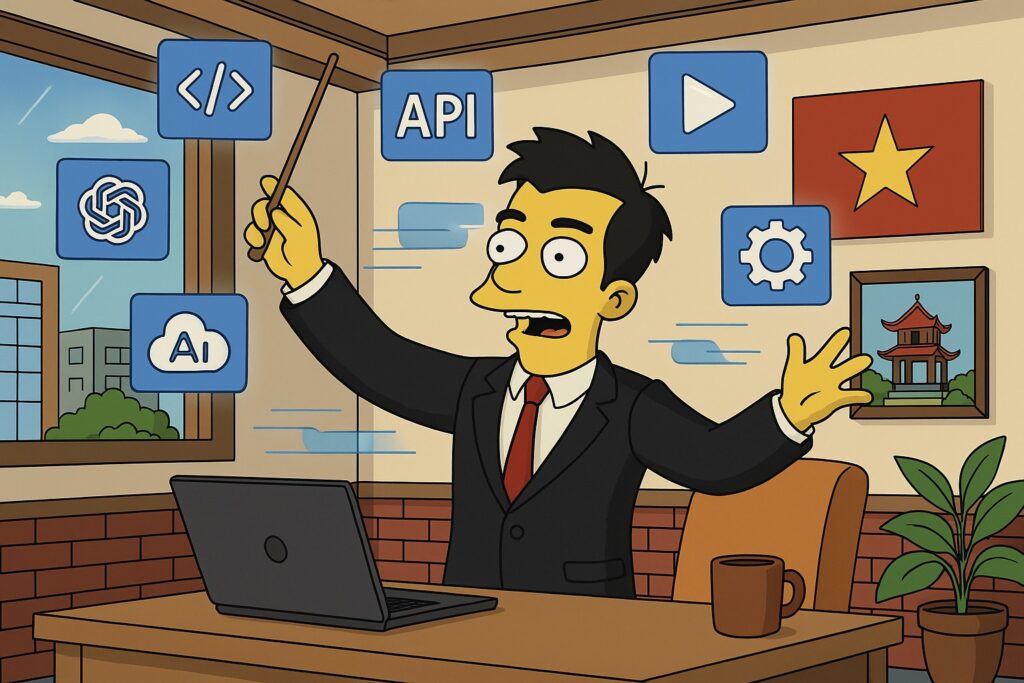
The Context Engineering Reality
The most powerful AI applications I’ve built require extensive context engineering, feeding the AI detailed documentation, examples, style guides, and business logic. Who creates this context? Humans who understand both the technical and business domains.
My AI agents work well because I spent weeks fine-tuning their prompts, providing comprehensive documentation, and building feedback loops. This isn’t “prompt and forget”, it’s ongoing collaboration between human intelligence and artificial intelligence.
The Layoff Excuse Theory
Recently, a lot of companies are using “AI replacement” as an excuse for layoffs while actually hiring cheaper labor. The H-1B visa fee increases that the Trump administration implemented targeted exactly this practice.
Companies aren’t actually replacing senior developers with AI. They’re replacing expensive senior developers with cheaper junior developers (often international hires) and claiming “AI efficiency improvements.” The numbers don’t add up when you look at actual productivity metrics.
If needed, you can check out the video here.
Disclaimer: This is a perspective I think valid, but it’s up to you to judge.
The Addiction Psychology: Why Vietnamese Developers Stay Hooked
Ralph’s video talks about the psychological aspects of coding addiction, and from a Vietnamese cultural perspective, this makes perfect sense.
The “Tinkerer” Culture
Vietnamese culture has this amazing tradition of fixing, modifying, and improving everything. Walk through any street in HCMC and you’ll see people customizing motorbikes, optimizing small business processes, or finding creative solutions to everyday problems.
Coding is like the ultimate expression of this tinkerer mentality. Instead of physically modifying objects, you’re digitally modifying reality.
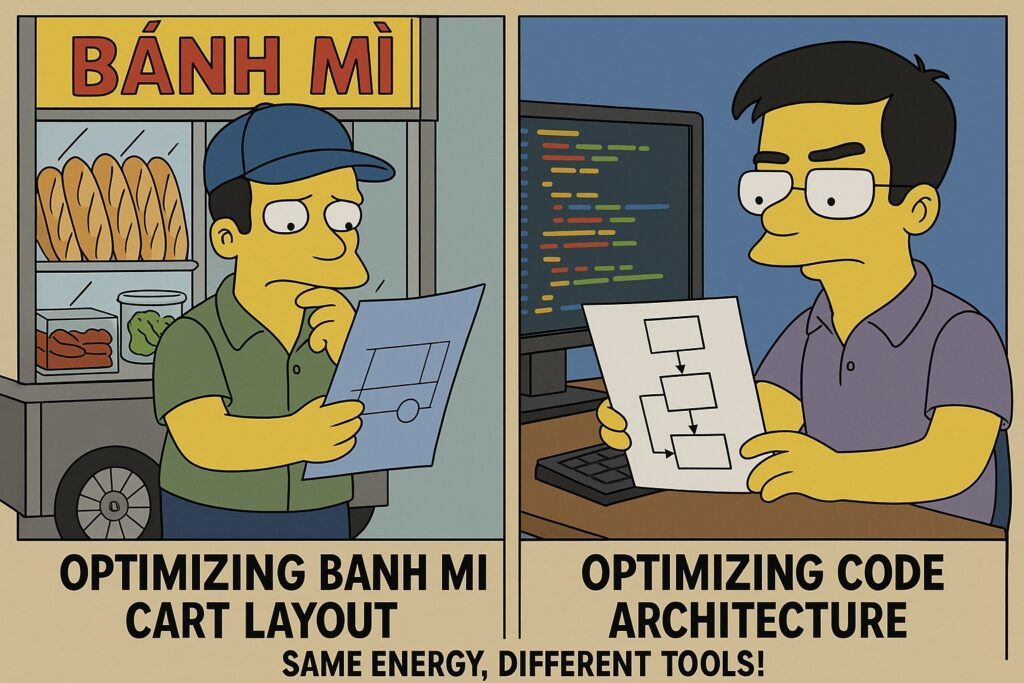
The Practical Application Satisfaction
Vietnamese culture values practical results. Abstract knowledge is nice, but applied knowledge that solves real problems gets respect. Coding delivers this satisfaction constantly.
When my backup script successfully prevents data loss, when my Wi-Fi automation saves time at coffee shops, and when my WordPress pipeline publishes posts while I sleep, these aren’t theoretical achievements. They’re tangible improvements to daily life.
The Future: Building Sustainable Coding Habits
Based on my experience and Ralph’s insights about curiosity-driven learning, here’s my advice for maintaining that coding addiction in a healthy, productive way:
1. Follow Your Vietnamese Context
Don’t just copy Western tutorials. Build solutions for Vietnamese problems:
- Payment integration with Vietnamese banks
- Motorbike delivery optimization
- Local weather and traffic APIs
- Vietnamese language processing
- Cultural event planning systems

2. Build for Your Community First
Start with problems that affect you and your Vietnamese friends/colleagues. That’s how I discovered the backup automation need, the WordPress workflow opportunity, and the HR screening platform potential.
3. Document Your Learning Journey
Keep notes on what works, what doesn’t, and why. This documentation becomes valuable context for future AI collaborations and helps other Vietnamese developers following similar paths.
4. Balance Individual and Collaborative Learning
Some days, code alone with coffee and focus. Other days, join study groups or work on open-source projects with Vietnamese developer communities.
Practical Next Steps: Your 30-Day Vietnamese Developer Challenge
Alright, inspired by Ralph’s challenge at the end of his video, here’s my version for Vietnamese developers:
Week 1: Experience the Magic Moment
- Install Python on your computer
- Write a script that scrapes Vietnamese news websites
- Make it send you daily summaries via Telegram
- Goal: Feel that “holy shit, it actually works” moment

Week 2: Solve a Personal Problem
- Identify one repetitive task in your daily routine
- Research Vietnamese APIs that might help (banking, weather, traffic)
- Build a simple automation script
- Goal: Save yourself 30+ minutes per week
Week 3: Add Intelligence
- Integrate an AI service (Gemini, OpenAI, or local models)
- Make your automation smarter and more adaptive
- Handle edge cases and error conditions
- Goal: Experience AI collaboration, not just automation
Week 4: Share and Iterate
- Document your project with Vietnamese and English explanations
- Share in Vietnamese developer communities
- Get feedback and implement improvements
- Goal: Complete the learning feedback loop
PlantUML Diagram – 30-Day Challenge Flow:
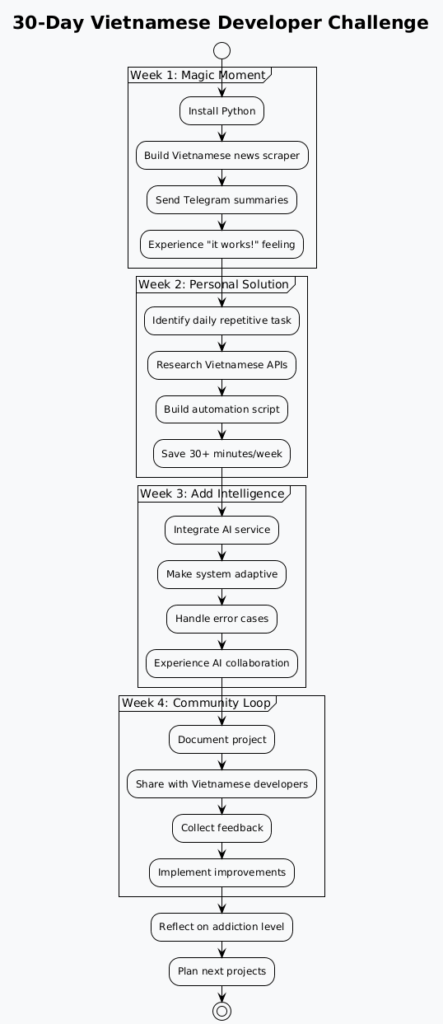
The Honest Truth: It’s Not All Dopamine and Magic
Let me be real with you for a moment. Ralph’s video shows the exciting, addictive side of coding, but there’s also frustration, confusion, and moments where you’ll question your sanity.
I spent 6 hours debugging a Docker container issue last month because I had a typo in an environment variable. Six hours. For one missing letter. Did I feel like a coding genius? Hell no. Did I learn something valuable about container architecture? Absolutely.
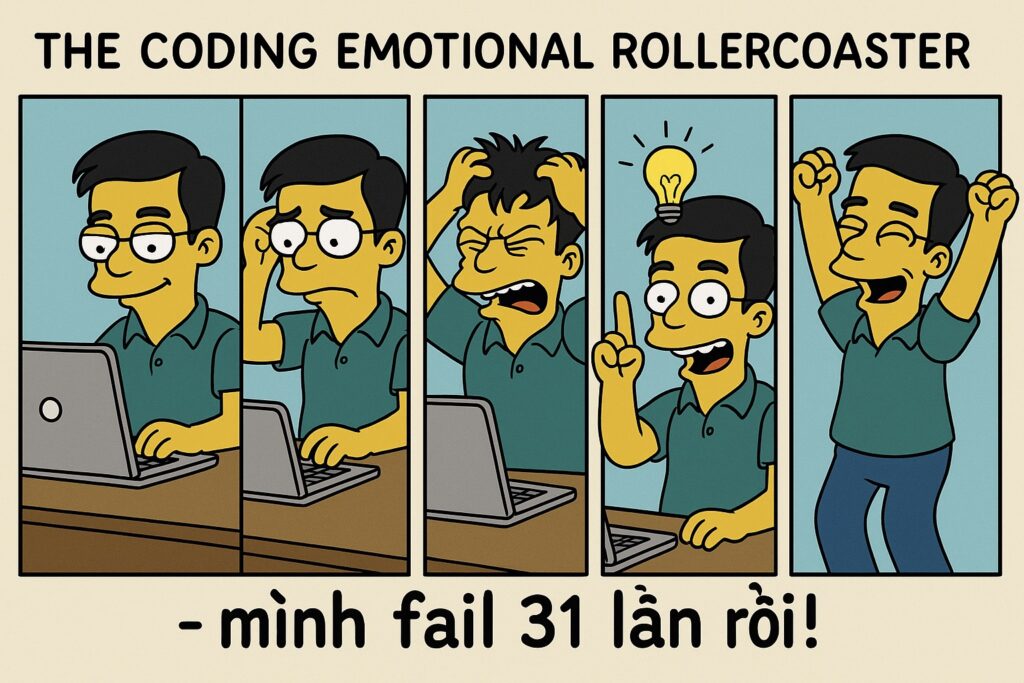
The addiction isn’t just about the wins. It’s about becoming comfortable with the process of:
- Breaking things and fixing them
- Not knowing the answer and figuring it out
- Reading documentation until it finally makes sense
- Asking for help without feeling embarrassed
The Vietnamese Perspective on Failure
In Vietnamese culture, we have this concept of “fail rồi làm lại thôi!” (failed, so let’s just do it again!). This mindset is perfect for coding because programming is essentially controlled failure iteration.
Every bug is a learning opportunity. Every broken script teaches you something about system design. Every successful deployment builds confidence for bigger challenges.
Kết Thúc: The Real Addiction
So what is this coding addiction that Ralph talks about and that I’ve experienced over the last few months?
It’s not addiction to syntax or frameworks or specific technologies. Those change constantly.
It’s addiction to the problem-solving process. The ability to take a frustrating situation – like manually backing up servers at 4 AM – and systematically build a solution that makes the problem disappear forever.
It’s addiction to growth. Every project teaches you something that makes the next project easier, more ambitious, or more creative.
It’s addiction to agency. In a world where many things feel out of our control, coding gives you a domain where your ideas can become reality through systematic effort.

And yes, it’s addiction to that moment when you see your code working in production, helping real people solve real problems, while you’re sleeping peacefully in your apartment in HCMC.
Ralph is right – once you experience this, you’ll never want to stop. But that’s not a bug, it’s a feature.
TL;DR Recap for Busy People
Main Message: Coding becomes addictive because it transforms you from someone who deals with problems to someone who eliminates problems systematically.
Key Vietnamese Developer Insights:
- Start with Vietnamese context problems (news scraping, local APIs, cultural applications)
- Embrace the “fail rồi làm lại thôi!” mindset for sustainable learning
- Use AI as orchestra musicians, but remain the conductor
- Technical skills dramatically improve business and academic capabilities
- Community learning accelerates individual progress
Next Action: Pick one repetitive task from your Vietnamese daily life and spend this weekend building a solution. Whether it’s checking HCMC traffic, tracking cryptocurrency prices, or organizing family photos make the computer solve it for you.
Chúc may mắn! (Good luck!) And remember, the goal isn’t to become a perfect coder. The goal is to become someone who sees problems and thinks, “I bet I could automate that.”
Mong được nghe góp ý và trải nghiệm của bạn! Drop a comment below if this resonates with your coding journey, or if you have questions about getting started with Vietnamese context projects.


